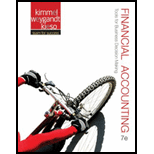
(a)
Accounts receivable refers to the amounts to be received within a short period from customers upon the sale of goods and services on account. In other words, accounts receivable are amounts customers owe to the business. Accounts receivable is an asset of a business.
Bad debt expense:
Bad debt expense is an expense account. The amounts of loss incurred from extending credit to the customers are recorded as bad debt expense. In other words, the estimated uncollectible accounts receivable are known as bad debt expense.
Percentage-of-receivables basis:
It is a method of estimating the
Allowance method:
It is a method for accounting bad debt expense, where uncollectible accounts receivables are estimated and recorded at the end of particular period. Under this method, bad debts expenses are estimated and recorded prior to the occurrence of actual bad debt, in compliance with matching principle by using the allowance for doubtful account.
Direct write-off method:
This method does not make allowance or estimation for uncollectible accounts, instead this method directly write-off the actual uncollectible accounts, by debiting bad debt expense and by crediting accounts receivable. Under this method, accounts would be written off only when the receivables from a customer remain uncollectible.
(a)
To determine: The amount would be reported as bad debt expense, if Company F uses the direct write-off method of accounting for bad debts.
(b)
The amount of bad debts expense would be recorded by Company F.
Given:
Balance in allowance for doubtful accounts is a credit of $3,000.
Bad debt expense is 4% of accounts receivable.
(c)
The amount of bad debts expense would be recorded by Company F.
Given: Balance in allowance for doubtful accounts is a debit of $1,000.
Bad debt expense is 4% of accounts receivable.
(d)
To describe: The weakness of reporting bad debt expense under direct write-off method.
Want to see the full answer?
Check out a sample textbook solution
Chapter 8 Solutions
Financial Accounting
- During October, Department X started and completed 92,000 units and also finished 28,000 units that were 60% completed on September 30. On October 31, Department X's ending inventory consisted of 25,000 units that were 40% completed. All manufacturing costs are incurred at a uniform rate throughout Department X's production process. Compute the number of equivalent full units of production for Department X during October. (FIFO Method) Correct answerarrow_forwardYour boss asks you to compute the company's cash conversion cycle. Looking at the financial statements, you see that the average inventory for the year was $157,800, accounts receivable were $128,500, and accounts payable were at $143,600. You also see that the company had sales of $412,000 and that cost of goods sold was $346,000. What is your firm's cash conversion cycle? Round to the nearest day.arrow_forwardI need help finding the accurate solution to this general accounting problem with valid methods.arrow_forward
- Arlind Corp.'s manufacturing overhead is 36% of its total conversion costs. If direct labor is $86,000 and direct materials are $29,000, the manufacturing overhead is __.arrow_forwardDuring October, Department X started and completed 92,000 units and also finished 28,000 units that were 60% completed on September 30. On October 31, Department X's ending inventory consisted of 25,000 units that were 40% completed. All manufacturing costs are incurred at a uniform rate throughout Department X's production process. Compute the number of equivalent full units of production for Department X during October. (FIFO Method)arrow_forwardGeneral Accountingarrow_forward

 AccountingAccountingISBN:9781337272094Author:WARREN, Carl S., Reeve, James M., Duchac, Jonathan E.Publisher:Cengage Learning,
AccountingAccountingISBN:9781337272094Author:WARREN, Carl S., Reeve, James M., Duchac, Jonathan E.Publisher:Cengage Learning, Accounting Information SystemsAccountingISBN:9781337619202Author:Hall, James A.Publisher:Cengage Learning,
Accounting Information SystemsAccountingISBN:9781337619202Author:Hall, James A.Publisher:Cengage Learning, Horngren's Cost Accounting: A Managerial Emphasis...AccountingISBN:9780134475585Author:Srikant M. Datar, Madhav V. RajanPublisher:PEARSON
Horngren's Cost Accounting: A Managerial Emphasis...AccountingISBN:9780134475585Author:Srikant M. Datar, Madhav V. RajanPublisher:PEARSON Intermediate AccountingAccountingISBN:9781259722660Author:J. David Spiceland, Mark W. Nelson, Wayne M ThomasPublisher:McGraw-Hill Education
Intermediate AccountingAccountingISBN:9781259722660Author:J. David Spiceland, Mark W. Nelson, Wayne M ThomasPublisher:McGraw-Hill Education Financial and Managerial AccountingAccountingISBN:9781259726705Author:John J Wild, Ken W. Shaw, Barbara Chiappetta Fundamental Accounting PrinciplesPublisher:McGraw-Hill Education
Financial and Managerial AccountingAccountingISBN:9781259726705Author:John J Wild, Ken W. Shaw, Barbara Chiappetta Fundamental Accounting PrinciplesPublisher:McGraw-Hill Education





